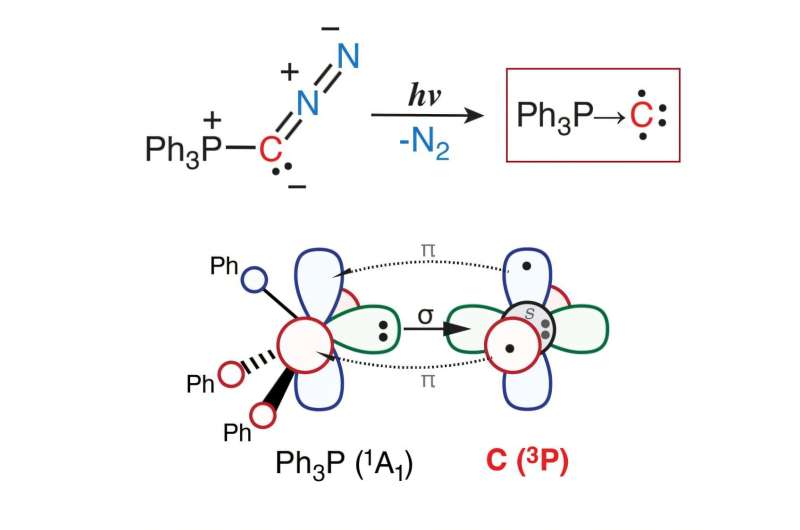This article has been reviewed according to Science X's editorial process and policies. Editors have highlighted the following attributes while ensuring the content's credibility:
fact-checked
peer-reviewed publication
trusted source
proofread
Exotic monovalent carbon compound features single bond with phosphorus group

Carbon, with its myriad compounds, is the backbone of life and the central element of organic chemistry. The number of bonds a carbon atom forms with other elements in a compound determines its chemical structure and behavior.
Normally, a carbon atom shares all four of its valence electrons to create four bonds with other atoms (tetravalent carbon). When fewer bonds are formed, unusual compounds such as carbenes are obtained, which have unique properties exploited in various fields of chemistry and catalysis. Rare cases exist of divalent carbon compounds called carbones, where a central neutral atom in an electronically excited state is stabilized by two bonds with neutral electron-pair donating groups.
Now, another milestone was achieved with the synthesis of an organic compound that contains a singly-bonded (monovalent) carbon atom in its ground state. This is an important step in chemistry as it opens up new possibilities for the development of compounds and reactions.
In a groundbreaking study published in Angewandte Chemie, the research teams of Dimitrios A. Pantazis (MPI für Kohlenforschung, Department of Molecular Theory and Spectroscopy), Müge Kasanmascheff, and Max M. Hansmann (TU Dortmund), report a chemical compound featuring a single carbon atom bonded to a phosphorus group, Ph3P→C. The compound was generated from a diazophosphorus ylide precursor by irradiation with ultraviolet (UV) light at very low temperatures, which led to elimination of N2 and formation of Ph3P→C.
Electron paramagnetic resonance (EPR) and electron–nuclear double resonance (ENDOR) spectroscopies revealed that the compound contains two unpaired electrons with parallel spins (a spin-triplet state). Advanced quantum chemical calculations probed the bonding and spin density distribution of the compound, showing that it represents a new type of carbon-centered diradical with a single dative bond between the phosphorus and the terminal carbon. This is the first known compound where a carbon center persists in the same electronic configuration and spin state as that of an isolated ground-state carbon atom.
This fundamental discovery extends the boundaries of carbon chemistry to the extreme bonding situation of a monovalent neutral carbon atom, while paving the way for exploring new organic reactivity with potential implications for synthesis, catalysis, and materials science.
More information: Yury Kutin et al, Ph3PC – A Monosubstituted C(0) Atom in Its Triplet State, Angewandte Chemie International Edition (2025). DOI: 10.1002/anie.202424166
Journal information: Angewandte Chemie International Edition , Angewandte Chemie
Provided by Max Planck Society





















